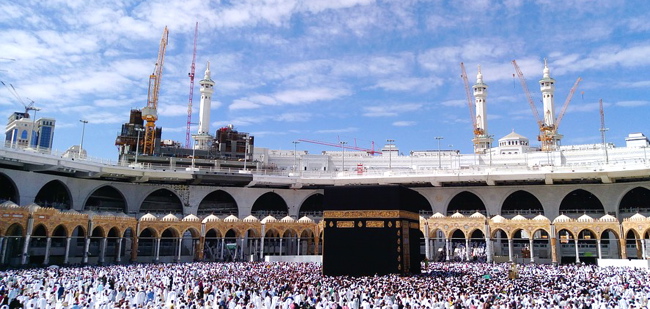
Hajj pilgrims circumambulating the Kaaba in Mecca, Saudi Arabia. The Kaaba is the most sacred site in Islam. Photo courtesy of Max Pixel
More than a billion Muslims around the world look to the Hajj, each year, as more than 2 million pilgrims travel to Mecca for to fulfill one of the five pillars of Islam.
SUNSET MONDAY, AUGUST 20: Eid Al-Adha, also known as the Feast of the Sacrifice, begins and runs through August 21. On the morning of Eid, crowds spill out of mosques, into open fields and in parks around the world, as Muslims celebrate both Ibrahim’s devotion and the miracle that took place on the sacrificial altar. Officially, Eid al-Adha begins after the descent of Mount Arafat by the pilgrims on Hajj in Mecca; Muslims across the globe gather with family and friends and offer prayers in congregation.
Hajj: Hajj is a religious duty that must be undertaken by every adult Muslim at least once in his or her lifetime (if it is manageable physically, mentally and financially); despite the frequently used phrase “religious duty,” Muslims regard Hajj as an experience to be treasured. Muslims believe that the ritual of a pilgrimage to Mecca stretches back centuries before the advent of Islam—to the time of Ibrahim (Abraham)—yet it was the Muslim Prophet Muhammad who cemented the rituals of Hajj, in the seventh century. The uniform method of performing the rituals of Hajj is meant to demonstrate both the solidarity of the Muslim people and their submission to God.
STORIES & TRADITIONS
Islamic tradition tells that in approximately 2000 BCE, Abraham was ordered by God to leave his wife, Hagar, and his son, Ishmael, alone in the desert of Mecca while he traveled to Canaan. After Abraham left, her food and water quickly ran out, so Hagar ran back and forth between the hills of Safa and Marwa seven times. Exhausted, Hagar laid Ishmael down on the sand and begged God for help. Miraculously, a well sprang up at the baby’s feet, and that well—the Zamzam Well—continues to provide ample water to Hajj pilgrims today.
Later, according to Muslim tradition, Abraham was commanded to build the Kaaba, so that people could perform pilgrimage there. It is believed that the Archangel Gabriel brought the Black Stone from heaven to be attached to the Kaaba; today, the Black Stone marks the beginning and ending point of each circle a pilgrim makes as he circulates the Kaaba during Hajj.
DESTINATION: MECCA
Muslims describe the era of pre-Islamic Arabia as jahiliyyah, a time of what Muslims regard as barbaric practices when the Kaaba had become surrounded by pagan idols. To cleanse the Kaaba, the Prophet Muhammad led his followers from Medina to Mecca in what is now regarded as the first Hajj. The pagan idols were destroyed, and Muhammad rededicated the Kaaba to God. At this point, Hajj became one of the five pillars of Islam, and adherents have been making the journey ever since. While on Hajj, men and women are permitted to perform the rituals side-by-side as a reminder that they will also stand together on Judgment Day.
RITUALS OF HAJJ
Prior to the start of Hajj, pilgrims go to the entry station where they bathe, don special clothing and make a statement of intent. The first ritual of Hajj is performed inside the Grand Mosque complex: pilgrims circle the Kaaba structure seven times, counterclockwise, reciting prayers (tawaf). Following tawaf, many drink from the Zamzam well. Next, Muslims walk rapidly between the hills of Sara and Marwa seven times, as Hagar did. Another statement of intent is made, after which the faithful travel through Mina, and on to the plains of Mount Arafat.
Intense prayer for forgiveness is offered at Arafat, as Muhammad said, “Far more people are freed from the Hellfire on the Day of Arafat than on any other day.” This portion of the Hajj journey is one of the most important. Small stones are gathered, and the following day, pilgrims perform a symbolic “stoning of the devil” at Mina.
Muslims the world over celebrate Eid al-Adha. Pilgrims return to Mecca to repeat Tawaf, crossing Sara and Marwa, performing additional symbolic stonings and circulating the Kaaba one final time, to do a farewell tawaf.

Tell Us What You Think